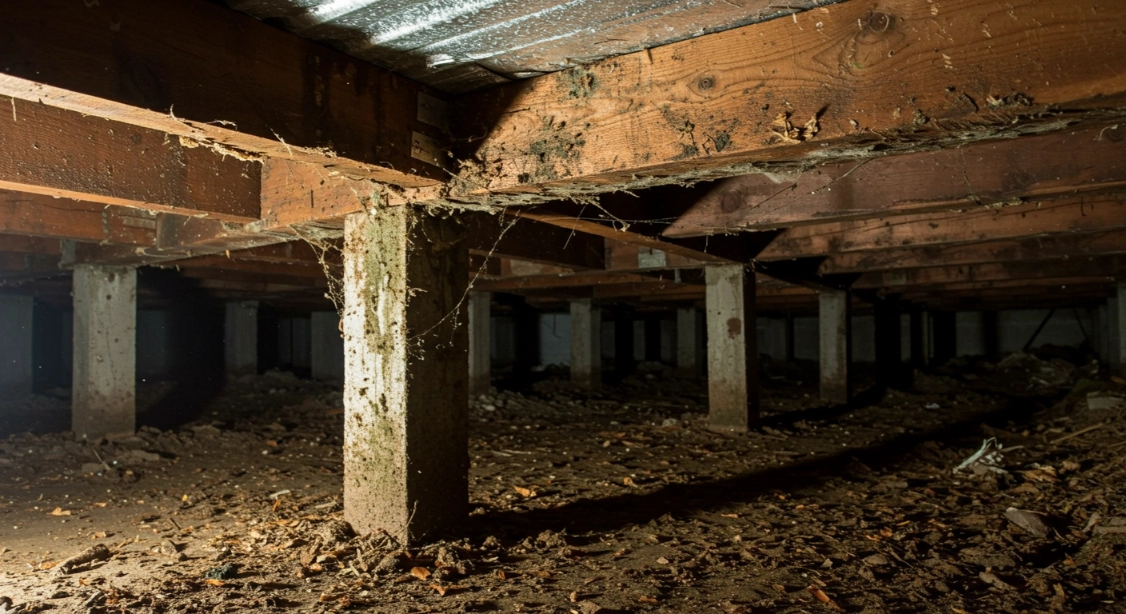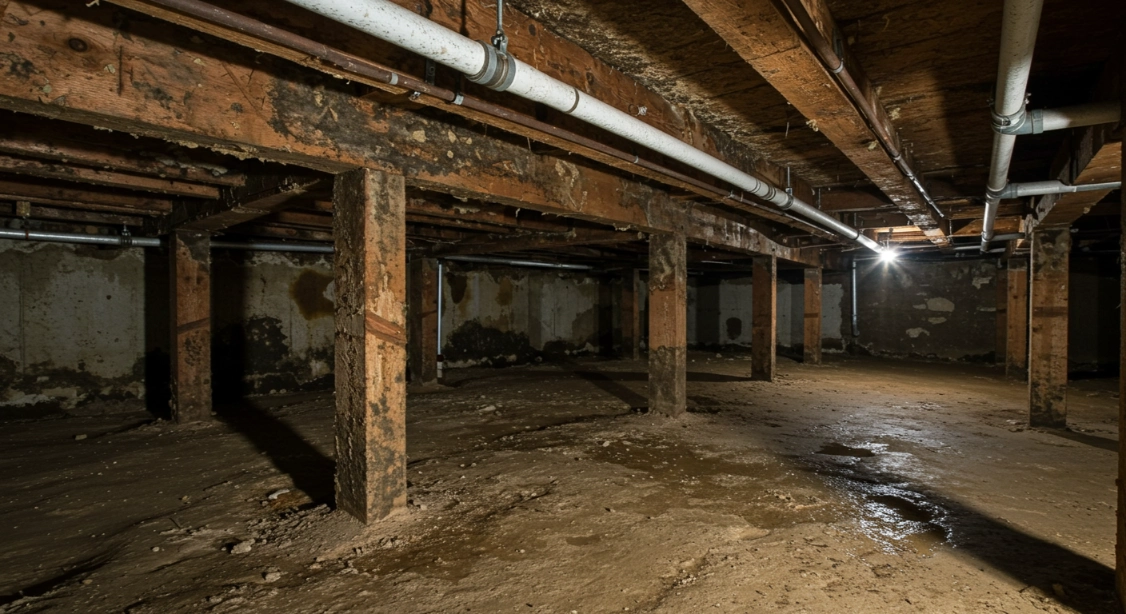Excess moisture in crawl spaces can trigger structural decay, indoor air quality issues, and energy inefficiency. Barton Creek’s humid subtropical climate amplifies these risks by creating persistent damp conditions under homes. Unchecked crawl space humidity can lead to mold growth, pest infestations, and insulation failure.
Crawlspace moisture management isn’t optional in Barton Creek. It’s a preventive step to maintain a stable foundation, improve indoor health, and avoid future remediation costs. This article presents a detailed breakdown of the risks, solutions, technical data, and real-world insights based on professional insulation work in the region.
What Causes Crawl Space Moisture in Barton Creek Homes
Regional Factors Driving Humidity Problems
Barton Creek experiences high rainfall and temperature fluctuations throughout the year. These conditions cause warm, moist air to seep into crawl spaces, where it condenses on cooler surfaces.
| Factor | Impact on Crawl Spaces |
|---|---|
| Average Annual Rainfall (34-36 in) | Prolonged ground saturation increases vapor migration |
| Summer Humidity Levels | Sustains high relative humidity under homes |
| Soil Composition (Clay) | Poor drainage retains moisture near foundations |
| Construction Age | Older homes often lack proper vapor barriers |
Construction and Design Flaws
- Vented crawl spaces draw in humid outside air, accelerating condensation.
- Absence of ground vapor barriers allows direct moisture intrusion.
- Inadequate or missing insulation creates thermal imbalances.
Bonus Tip: Homes with shaded perimeters or heavy landscaping retain ground moisture longer, making crawl space sealing even more critical.
Technical Impact of Moisture on Home Performance
| Parameter | With Moisture Problems | Without Moisture Problems |
|---|---|---|
| Indoor Air Quality | Mold spores, allergens | Cleaner, drier air |
| Energy Bills | increase (DOE, 2023) | Stable, optimized usage |
| HVAC Efficiency | Reduced system lifespan | Consistent performance |
| Wood Structural Health | Rot and insect vulnerability | Dry, preserved structural wood |
| Insulation Performance | Compromised, absorbs moisture | Maintains R-value integrity |
Source: U.S. Department of Energy, 2023 Moisture Control Guidelines
Things to Consider Before Making a Decision
- Moisture Source Assessment: Identify whether water intrusion is from ground, air, or plumbing.
- Crawlspace Type: Vented vs. unvented designs require different insulation and sealing approaches.
- Material Suitability: Not all insulation types perform well in damp conditions. Choose based on permeability and absorption rates.
- Access for Installation: Low-clearance crawl spaces may limit insulation methods.
- Code Compliance: Texas building codes may require Class I vapor retarders for enclosed crawl spaces.
Bonus Tip: Pre-installation humidity testing ensures accurate sizing of dehumidifiers or vapor barriers.
Recommended Moisture Control Methods
Comparative Table of Common Solutions
| Solution Type | Description | Pros | Cons |
|---|---|---|---|
| Vapor Barrier | Polyethylene sheets covering soil | Effective at ground moisture control | Must be sealed properly |
| Closed Cell Spray Foam | Rigid foam applied to crawlspace walls | Moisture resistant, adds R-value | Higher upfront cost |
| Dehumidifier Systems | Mechanical removal of moisture | Immediate humidity control | Requires electrical access |
| Crawlspace Encapsulation | Sealed liner on floors and walls | Comprehensive barrier | Labor-intensive installation |
Source: Building Science Corporation, 2022 Best Practices Report

Real Experience from Barton Creek Projects
Homes near the Barton Creek Greenbelt often deal with elevated soil humidity due to surrounding vegetation and limited sun exposure. Installation teams have consistently observed that closed cell spray foam provides long-term protection by blocking vapor entry and supporting thermal regulation.
In several post-install evaluations, encapsulated crawl spaces saw relative humidity levels drop within two weeks, improving indoor comfort and reducing musty odors. This highlights the effectiveness of proper Crawl Space Insulation in maintaining moisture control and enhancing overall indoor air quality.
Most Relevant Services Provided by Stellrr Insulation & Spray Foam
- Crawl Space Insulation: Installs insulation resistant to mold and moisture to protect structural components.
- Closed Cell Insulation: Applied directly to crawl space walls for superior air and vapor sealing.
- Insulation Removal: Safely removes old or compromised materials affected by moisture or pests.
- Wall Insulation: Adds another layer of moisture resistance in adjacent basement or lower-level areas.
Common Questions Homeowners Ask Before Starting
Is encapsulation worth it for a vented crawl space?
Yes, it provides better control over humidity and reduces heating and cooling inefficiencies.
Can I just use a dehumidifier without insulation?
No. Moisture will continue to seep in without a barrier. Dehumidifiers help manage, not prevent.
How do I know if my crawl space has a moisture problem?
Look for moldy smells, warped floors, rusted metal, or visible dampness on walls or insulation.
What’s the best time of year to insulate the crawl space?
Dry seasons, typically late summer or early fall in Barton Creek, are best for installation.
Get Expert Insulation Guidance
Moisture in Barton Creek crawl spaces is a solvable issue with the right strategy and materials. Accurate diagnosis, expert installation, and the correct insulation type are key to protecting your home.
Contact Stellrr Insulation & Spray Foam for assessment and crawl space moisture solutions:
Phone: (512) 710-2839 Email: info@stellrr.com
FAQ About Crawl Space Moisture Management
How often should crawl spaces be checked for moisture?
Twice a year, ideally before and after the wet season.
Does closed cell insulation replace the need for vapor barriers?
In many cases, yes. Its low permeability makes it function as both insulator and barrier.
Can moisture in the crawlspace affect hardwood floors?
Yes. Prolonged exposure can cause warping, cupping, or mold under flooring.
Will insulation fix existing mold problems?
No. Mold must be remediated before installing new materials.
What is the lifespan of crawl space insulation?
Closed cell spray foam typically lasts over 25 years if undisturbed.

